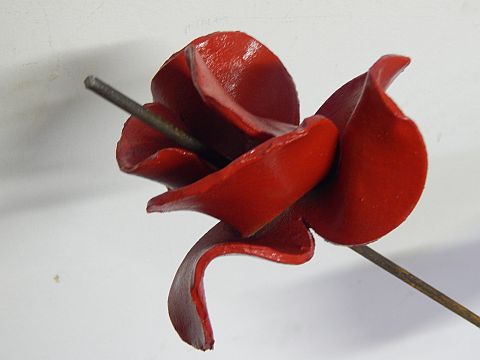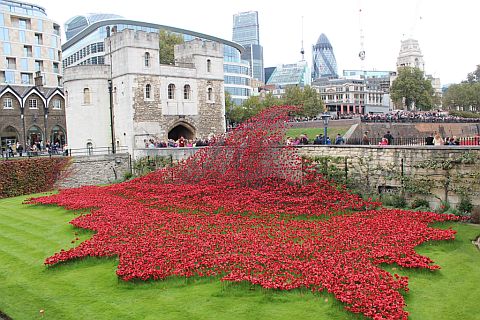

 The South African
The South African

Ditsong National Museum of Military History recently accepted the donation of a unique hand-made piece of art. This is a ceramic poppy which formed part of the familiar work of installation art entitled 'Blood-swept lands and seas of red' in the moat of the Tower of London from 17 July to 11 November 2014 to commemorate the start of the centenary of the First World War (1914-1918). The Museum is honoured to have this symbolic object in its collection.
The installation was the brain-child of Paul Cummins, an international ceramic artist from Derbyshire in the United Kingdom (Your piece of history, 2014, p1). His inspiration for surrounding the Tower of London with 888 246 ceramic poppies came from reading a note he came across in a library in Chesterfield in 2013 which was written by an unknown Derbyshire soldier who had died in Flanders. British soldiers were encouraged to write notes for their families in the event of their death. This one was unsigned, but, at the bottom, appeared the words: 'The blood-swept lands and seas of red, where angels fear to tread' (Shute, 2014, p2). The artist teamed up with Olivier Award winning stage designer, Tom Piper, and Historic Royal Palaces, which administers the Tower of London, to bring his idea of an unforgettable visual installation to life (Your piece of history, 2014, p5).

Each of the poppies was handcrafted using a team at Cummins' own ceramic works in Derbyshire and two other teams working in Stoke-on-Trent and Aylesbury. According to the https://en.wikipedia.org entry, 'Blood Swept Lands and Seas of Red', quoting http://www.stokesentinel.co.uk/Business-Family-firm-Potclays-supplies-materials/story-21090630-details/story.htmland 'Tower poppies' debt to the Potteries' in The Guardian, 29 December 2014), Potclays Ltd in Stoke-on-Trent supplied the 497 000 kg of Etruria Marl-based Etruscan red earthenware and most of the equipment and materials used to make the poppies. Blocks of clay were sliced into sheets and formed into poppies using large and small petal stamps before being kiln-fired. On completion, the poppies were added to the installation progressively by volunteers (Your piece of history, 2014, p2). It was initially envisaged that about 50 people a day would volunteer to plant the poppies. By the end of the project, however, some 25 000 volunteers from all around the world were involved in transforming the Tower's moat into a sea of red (Shute, 2014, p3).
Piper designed the installation of the poppies to appear as water or blood seeping from the Tower and pouring out of a bastion window, known as the 'Weeping Window', in waves which gradually filled the moat. His creative approach allowed the poppies to behave like a real field of growing plants with natural undulations of varying heights. The volunteers were also allowed to use their own influence and imagination in the growing of the sea of poppies with each team planting them in a slightly different manner. The intention of the installation was that each of the 888 246 ceramic flowers planted would represent one British or Empire military fatality of the war.
The first poppy was planted by Yeoman Warder, Crawford Butler, on 17 July 2014 and the official opening of the installation took place on 5 August, marking the centenary of Britain's entry into the war. As part of the official opening, the Duke and Duchess of Cambridge, along with the Duke's brother Prince Harry, paid a visit to the installation. Her Majesty the Queen and the Duke of Edinburgh visited the installation on 16 October. On that occasion, the Queen laid a wreath of poppies in the moat (Shute, 2014, pp3-4). The sea of red grew steadily over the four months of the exhibition. At sunset on each day from 1 September to 11 November, the names of 180 First World War servicemen, nominated by the public to appear on a Roll of Honour, were read out by a Yeoman Warder, followed by the sounding of the Last Post. The last flower was planted on 11 November by a thirteen year old cadet, Harry Hayes, from the Combined Cadet Force of Reading Blue Coat School ('Cadet Harry Hayes, 13, plants last of 888 246 poppies in Tower of London moat' in The Daily Telegraph, 11 November 2014, quoted in Wikipedia, 'Blood Swept Lands and Seas of Red').
On 12 November, a team of around 8 000 volunteers began to remove the poppies. Throughout the exhibition, people were able to pre-order an individual poppy for £25. As indicated in the commemorative booklet (Your piece of history, 2014, pp6-7), a share of the proceeds of the sale of the poppies, estimated at more than £15 million, would go to six service charities: The Confederation of Service Charities (COBSEO), Combat Stress, Coming Home, Help for Heroes, the Royal British Legion's Admiral Nursing Service and the Soldiers, Sailors, Airmen and Families Association (SSAFA).
It is estimated that some five million people from all over the world visited the installation, including people affected by Britain's most recent conflicts (BBC News, 11 November 2014, quoted in Wikipedia). Shute (2014, p4) describes the visit by Ben McBean, a former Royal Marine who lost his leg and arm seven years ago in a landmine blast in Helmond Province, who said: 'I was gobsmacked really. I'm quite a loud person but when I visited I didn't say a word for about fifteen minutes. There was just so much to be taken in. I was thinking about friends I lost out in Afghanistan and my uncle who was in the Royal Marines, as well as what happened to me. I also remembered a video they showed us in training of a guy in the D-Day landings who jumped off a craft and was gunned down in five seconds. That is what the poppy is: a symbol of remembrance'. Dr Stephen Clark, Head of Remembrance at the Royal British Legion who visited the installation almost weekly, stated (Shute, 2014, p4): 'It has captured the imagination of the public. It is the feeling of being part of something. To see the moat was one thing. To be at the Tower at dusk when the sun is setting and lights flickering on along the Thames, is something else.'
The huge visitor demand led to calls by prominent personalities, including the British Prime Minister, for an extension of the period of the exhibition ('David Cameron joins plea to extend Tower of London poppies' in The Daily Telegraph, 7 November 2014, quoted in Wikipedia). Cummins and officials of Historic Royal Palaces resisted such calls, stating that the transience of the installation was a key part of the artist's concept and that the poppies would be removed as planned and distributed to the people who had purchased individual flowers. It was, however, announced that the wave segment, consisting of a steel construction covered in poppies at the Tower entrance, would remain in place until the end of November. Both the wave and the weeping window segments would then be exhibited throughout the United Kingdom over the entire period of the centenary of the First World War and, in 2018, they would go on permanent display at the London and Manchester components of the Imperial War Museum respectively ('Poppy display segment at Tower of London given extension', BBC News, 8 November 2014, quoted in Wikipedia).
The Queen paid tribute to the exhibition during her annual Christmas message. Both Cummins and Piper were awarded the MBE (Member of the Order of the British Empire) in the New Year Honours List in recognition of their work ('NY Honours for poppy duo, Joan Collins and John Hurt' BBC News, 31 December 2014, quoted in Wikipedia).

The Ditsong National Museum of Military History is indebted to a long-time friend, Mr Mike Hardisty, for making sure that one of the ceramic poppies from the Tower of London installation became part of its First World War Centenary collection. The poppy comes with a booklet and a certificate signed by Paul Cummins. In the booklet is written: 'Thank you for buying this poppy. We hope that you will treasure your piece of history which was and will continue to be part of the most significant and emotive commemoration of the First World War centenary'. The Museum plans to display the poppy as a tribute to the South Africans who lost their lives during the First World War.
Sources
Commemorative booklet, Your Piece of History (London, Historic Royal Palaces, 2014).
'Blood-Swept Lands and Seas of Red' at www.wikipedia.com. accessed July 2015.
Shute, J, 'Poppy Appeal: A Sea of Humanity Sweeps to the Tower of London' at www.telegraph.co.uk accessed July 2015.
Gallager, P, 'Spill of Poppies Commemorate Fallen of First World War' at www.dangerousminds.net accessed July 2015.
Return to Journal Index OR Society's Home page
South African Military History Society / scribe@samilitaryhistory.org